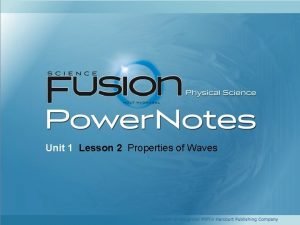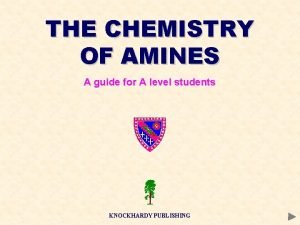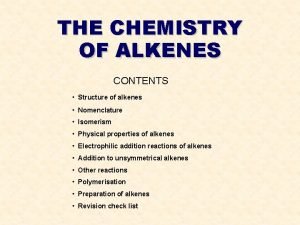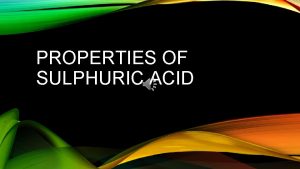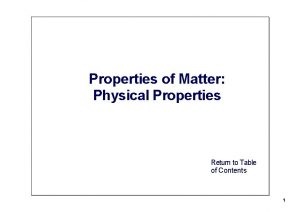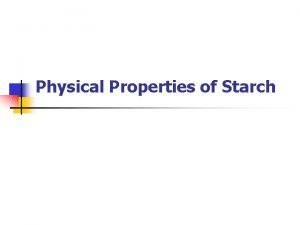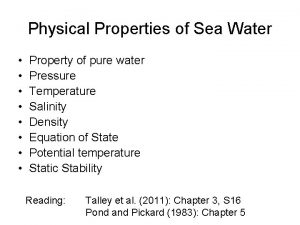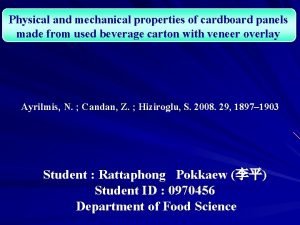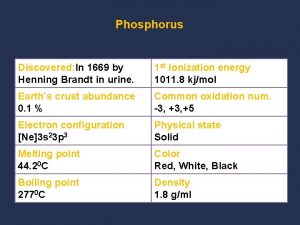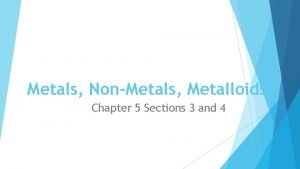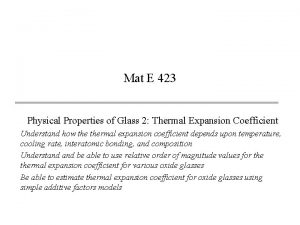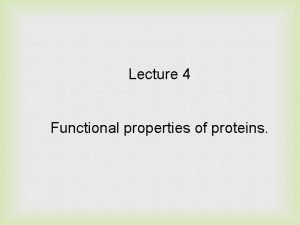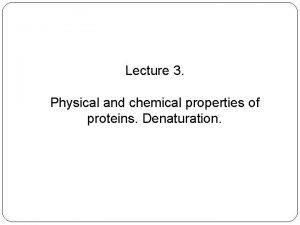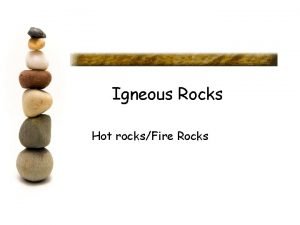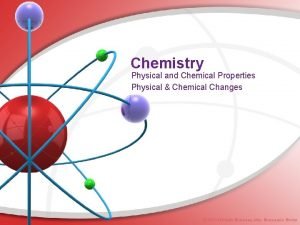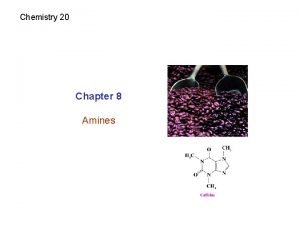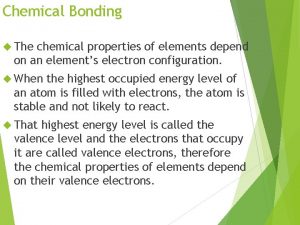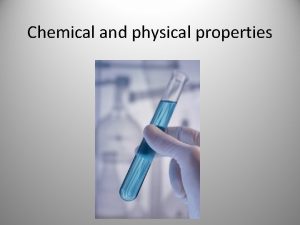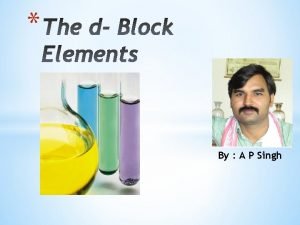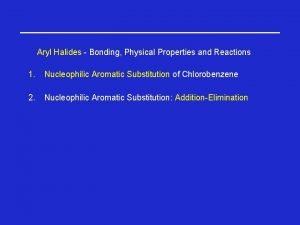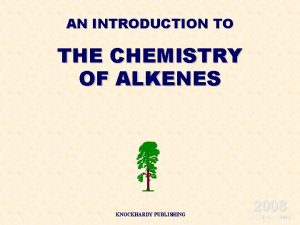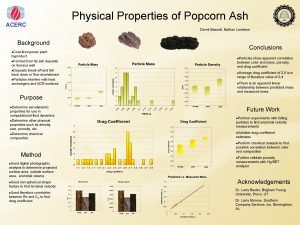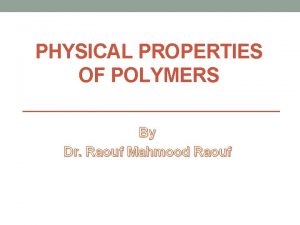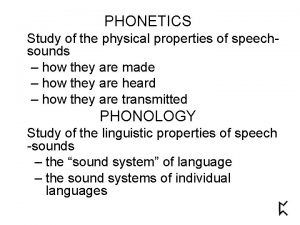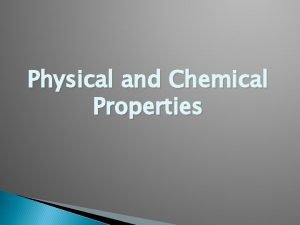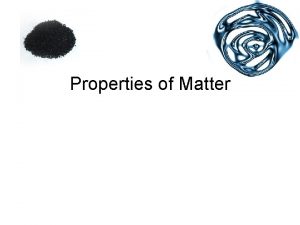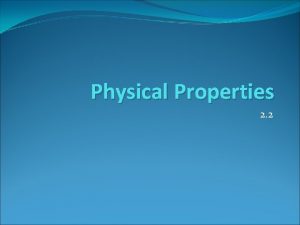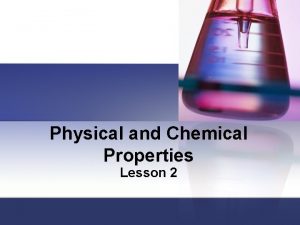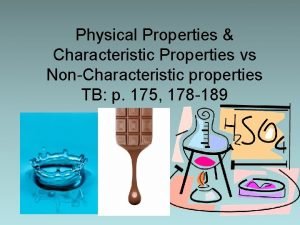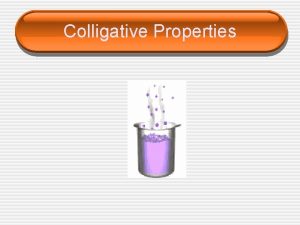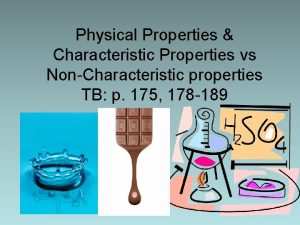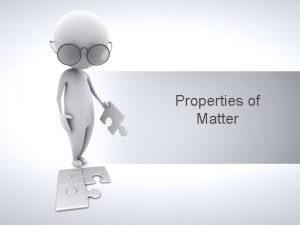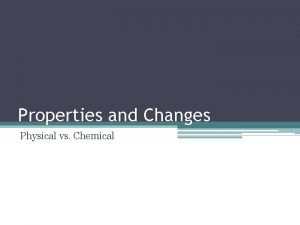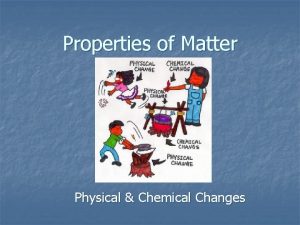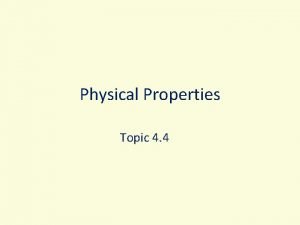Physical Properties LESSON 2 Physical Properties LESSON INTRODUCTION






































- Slides: 38

Physical Properties

LESSON 2 Physical Properties LESSON INTRODUCTION Get Ready What do you think? Before you begin, decide if you agree or disagree with each of these statements. As you view this presentation, see if you change your mind about any of the statements.

LESSON 2 Physical Properties LESSON INTRODUCTION Get Ready Do you agree or disagree? • The weight of a material never changes, regardless of where it is. • Boiling is one method used to separate parts of a mixture.

LESSON 2 Physical Properties LESSON INTRODUCTION Key Concepts/Essential Questions • What are some physical properties of matter? • How are physical properties used to separate mixtures?

LESSON 2 Physical Properties Vocabulary Watch out for these words! • physical property • mass • density • solubility LESSON INTRODUCTION

LESSON 2 Physical Properties LESSON INTRODUCTION Panning by Properties? Look at the photo at the beginning of the lesson. The man lowers his pan into the waters of an Alaskan river and scoops up a mixture of water, sediment, and hopefully gold. As he moves the pan in a circle, water sloshes out of it. If he is careful, gold will remain in the pan after the water and sediment are gone. What properties of water, sediment, and gold enable this man to separate this mixture?

LESSON 2 Physical Properties Lesson 2: Physical Properties 1. A(n) physical property is a characteristic of matter that you can observe or measure without changing the identity of the matter. 2. State of matter is a physical property. a. The common states of matter on Earth are solid, liquid, and gas. b. The state of matter depends on how close the particles are and how quickly they

LESSON 3. Some physical properties are size-dependent, which means the measurement of the property depends on how much matter is present. 4. Mass is a size-dependent property because it is a measure of the amount of matter in a sample. a. Mass is sometimes confused with weight, which is the pull of gravity on matter. b. Weight changes with location, but mass does not.

LESSON 5. Volume is the amount of space something takes up. 6. Other physical properties are size-independent because they do not depend on how much matter is present. 7. Melting point and boiling point are sizeindependent properties. a. Melting point is the temperature at which a(n) solid changes to a(n) liquid. b. The temperature at which a liquid changes to a gas is the boiling point.

LESSON 8. Density is the amount of mass per unit volume. 9. Electrical conductivity is the ability of matter to carry an electric current; thermal conductivity is the ability of matter to carry thermal energy. 10. Solubility is the ability of one substance to dissolve in another.

LESSON 11. The parts of a mixture can be separated using the physical properties of the components. a. Salt and water can be separated because the boiling point of water is much lower than that of salt. b. A solid can be separated from a liquid by filtering if the solid does not dissolve in the liquid. .

LESSON c. Oil and water can be separated because they have different densities. d. A(n) magnet can be used to separate materials that contain iron from other materials

LESSON 2 Physical Properties LESSON WRAP-UP Lesson Review Do you agree or disagree? • The weight of a material never changes, regardless of where it is. Disagree. Mass never changes based on location, but weight can.

LESSON 2 Physical Properties LESSON WRAP-UP Lesson Review Do you agree or disagree? Boiling is one method used to separate parts of a mixture. Agree. Each part of a mixture has a unique boiling point.

LESSON 2 Physical Properties LESSON WRAP-UP Key Concept/Essential Question Review What are some physical properties of matter? Physical properties of matter include size, shape, texture, and state.

LESSON 2 Physical Properties LESSON WRAP-UP Key Concept/Essential Question Review How are physical properties used to separate mixtures? Physical properties such as density, melting point, boiling point, and size can be used to separate mixtures.

LESSON WRAP-UP Key Concept/Essential Question Review Discussion Question Give an example of two substances you could separate using the boiling-point method and two substances you could separate using the filtering method.

LESSON WRAP-UP Key Concept/Essential Question Review Sample answers: boiling point—sugar and water; filtering—sand water

LESSON Physical Changes

LESSON 3 Physical Changes LESSON INTRODUCTION Get Ready What do you think? Before you begin, decide if you agree or disagree with each of these statements. As you view this presentation, see if you change your mind about any of the statements.

LESSON 3 Physical Changes LESSON INTRODUCTION Get Ready Do you agree or disagree? • Heating a material decreases the energy of its particles. • When you stir sugar into water, the sugar and water evenly mix.

LESSON 3 Physical Changes LESSON INTRODUCTION Key Concepts/Essential Questions • How can a change in energy affect the state of matter? • What happens when something dissolves? • What is meant by conservation of mass?

LESSON 3 Physical Changes Vocabulary Watch out for these words! • physical change LESSON INTRODUCTION

LESSON 3 Physical Changes LESSON INTRODUCTION Change by Chipping? Look at the photo at the beginning of the lesson. This artist is changing a piece of wood into an instrument that will make beautiful music. He planned and chipped, measured and shaped. Chips of wood flew, and rough edges became smooth. Although the wood changed shape, it remained wood. Its identity did not change, just its form.

LESSON 3 Physical Changes Lesson 3: Physical Changes A. Physical Changes 1. In a(n) physical change, the matter’s identity stays the same. a. A physical change involves a change in size, shape, form, or state. b. Although the matter’s identity stays the same, its properties might change.

LESSON 2. When food is chewed, matter undergoes a physical change in shape and size. 3. Matter undergoes a physical change when it changes from one state to another. a. A change in state involves a change in the energy of the particles. b. The energy of particles changes when thermal energy is added or removed.

LESSON 4. When thermal energy is added to particles, they move faster and temperature increases. a. When particles move faster, they can overcome the attractive forces that hold them together. b. When enough energy is added to a solid for it to change to a liquid, the solid has reached its melting point. c. When enough energy is added to a liquid for it to change to a gas, the liquid has reached its boiling point.

LESSON d. Sometimes, when energy is added to a solid, it undergoes sublimation, in which it changes directly from a solid to a(n) gas without first becoming a(n) liquid. 5. When thermal energy is removed from particles, they move slower and temperature decreases. a. When particles move slower, they are drawn closer together by attractive forces between them.

LESSON b. When enough energy is removed from a gas for it to change to a liquid, the gas condenses. c. When enough energy is removed from a liquid for it to change to a solid, the liquid freezes. d. If a gas changes directly to a solid without first becoming a liquid, the gas undergoes deposition.

LESSON 6. Melting and freezing are reverse processes, as are condensation and boiling and sublimation and deposition. 7. Dissolving, during which one substance evenly mixes with another substance, is also a physical change. 8. Some types of physical changes are reversible, such as when a solid changes to a liquid and then the liquid changes back into a(n) solid.

LESSON B. Conservation of Mass 1. The particles that are present before a physical change are also present after the change. 2. Therefore, mass also is the same before and after a physical change.

LESSON 3 Physical Changes LESSON WRAP-UP Lesson Review Do you agree or disagree? Heating a material decreases the energy of its particles. Disagree. Heating a material increases the energy of its particles.

LESSON 3 Physical Changes LESSON WRAP-UP Lesson Review Do you agree or disagree? When you stir sugar into water, the sugar and water evenly mix. Agree. When you stir sugar into water, the particles evenly mix.

LESSON 3 Physical Changes LESSON WRAP-UP Key Concept/Essential Question Review How can a change in energy affect the state of matter? A change in energy can change the state of matter.

LESSON 3 Physical Changes LESSON WRAP-UP Key Concept/Essential Question Review What happens when something dissolves? When something dissolves, it mixes evenly in a substance.

LESSON 3 Physical Changes LESSON WRAP-UP Key Concept/Essential Question Review What is meant by conservation of mass? The masses before and after a change in matter are equal.

LESSON Discussion Question: Are all physical changes reversible? Explain.

LESSON Answer: No; changes in shape or size (such as cutting paper) are not reversible, though changes in state and dissolving are reversible.
 Lesson 3 physical changes answer key
Lesson 3 physical changes answer key Chemical property of matter
Chemical property of matter Wave properties lesson 2
Wave properties lesson 2 Extensive vs intensive
Extensive vs intensive Amino acid optical isomers
Amino acid optical isomers Physical properties of alkenes
Physical properties of alkenes Physical and chemical properties of sulphuric acid
Physical and chemical properties of sulphuric acid 2 hydrogen 1 oxygen
2 hydrogen 1 oxygen Ethan is observing chemical and physical properties
Ethan is observing chemical and physical properties Physical property of starch
Physical property of starch Physical properties of sea water
Physical properties of sea water Thermal conductivity in dentistry
Thermal conductivity in dentistry Moreau
Moreau Physical properties
Physical properties Henning brandt
Henning brandt Physical properties of paint
Physical properties of paint The physical properties of metals include luster and
The physical properties of metals include luster and Malleability defintion
Malleability defintion Thermal expansion of glass
Thermal expansion of glass Physical properties of protein
Physical properties of protein Protein solubility
Protein solubility Pumice crystal size
Pumice crystal size Don't gamble with physical properties for simulations
Don't gamble with physical properties for simulations Qualitative physical properties
Qualitative physical properties Naming amine
Naming amine Physical properties of elements depend on
Physical properties of elements depend on Helium physical and chemical properties
Helium physical and chemical properties Physical properties of solutions
Physical properties of solutions Physical properties of d-block elements
Physical properties of d-block elements Aryl halife
Aryl halife Physical properties of alkenes
Physical properties of alkenes Glowing splint
Glowing splint Propofol physical properties
Propofol physical properties Properties of magma
Properties of magma Physical properties of popcorn
Physical properties of popcorn Properties of polymers
Properties of polymers Metals and non metals
Metals and non metals The study of the physical properties of speech sounds
The study of the physical properties of speech sounds Physical properties of inner core
Physical properties of inner core


